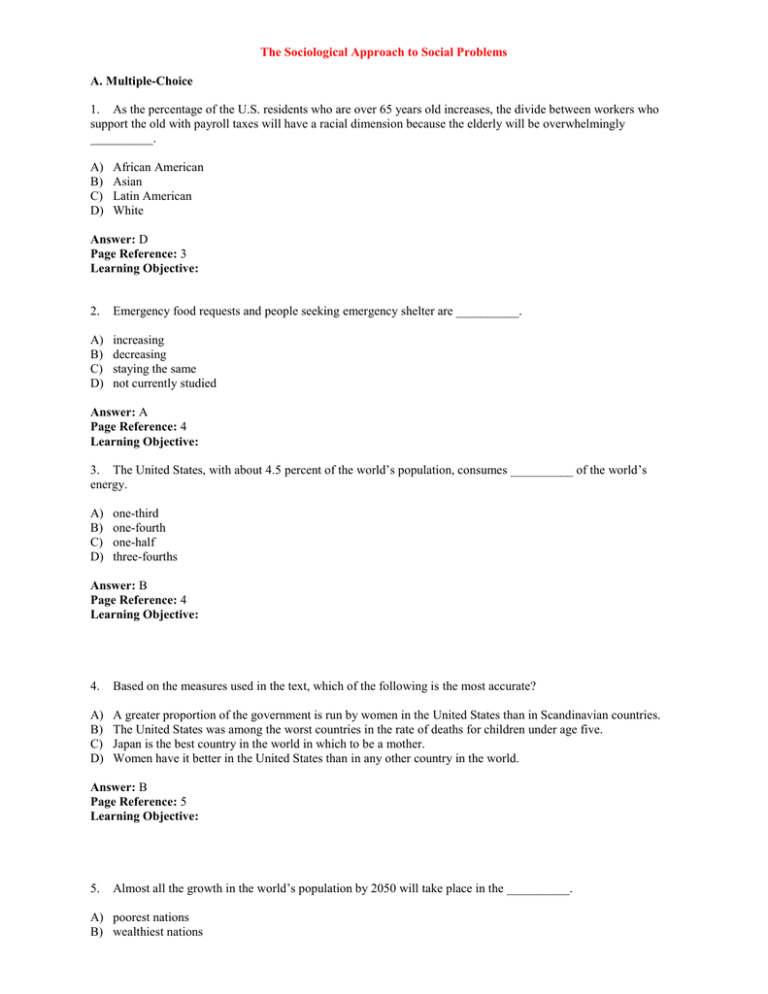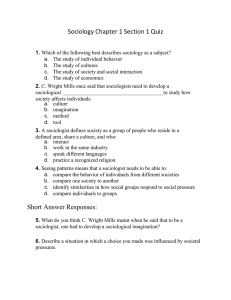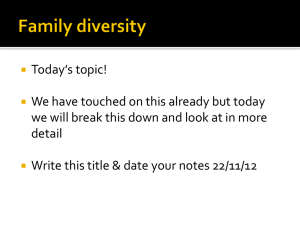The Sociological Approach to Social Problems A. Multiple
advertisement

The Sociological Approach to Social Problems A. Multiple-Choice 1. As the percentage of the U.S. residents who are over 65 years old increases, the divide between workers who support the old with payroll taxes will have a racial dimension because the elderly will be overwhelmingly __________. A) B) C) D) African American Asian Latin American White Answer: D Page Reference: 3 Learning Objective: 2. Emergency food requests and people seeking emergency shelter are __________. A) B) C) D) increasing decreasing staying the same not currently studied Answer: A Page Reference: 4 Learning Objective: 3. The United States, with about 4.5 percent of the world’s population, consumes __________ of the world’s energy. A) B) C) D) one-third one-fourth one-half three-fourths Answer: B Page Reference: 4 Learning Objective: 4. Based on the measures used in the text, which of the following is the most accurate? A) B) C) D) A greater proportion of the government is run by women in the United States than in Scandinavian countries. The United States was among the worst countries in the rate of deaths for children under age five. Japan is the best country in the world in which to be a mother. Women have it better in the United States than in any other country in the world. Answer: B Page Reference: 5 Learning Objective: 5. Almost all the growth in the world’s population by 2050 will take place in the __________. A) poorest nations B) wealthiest nations C) United States D) European Union Answer: A Page Reference: 5 Learning Objective: 6. Half of the people in the world live on less than __________. A) B) C) D) $0.25 a day $0.50 a day $1 a day $2 a day Answer: D Page Reference: 5 Learning Objective: 7. The __________ nature of social problems illustrates that social problems vary by time, place, and definition. A) B) C) D) economic objective political subjective Answer: D Page Reference: 7 Topic/A-head: History of Social Problems Theory 8. In the most recent direction of the study of deviance, __________. A) B) C) D) labeling people as abnormal has helped to clarify that they are the source of most social problems it is understood that social structures contribute to the perpetuation of deviance it is understood that deviants bring their problems on themselves labeling is seen as irrelevant in creating and sustaining deviance Answer: B Page Reference: 7 Topic/A-head: History of Social Problems Theory 9. The __________ nature of social problems describes societal conditions that harm certain segments of the population. A) B) C) D) economic objective political subjective Answer: B Page Reference: 8 Topic/A-head: Toward a Definition of Social Problems 10. According to the text, __________ often escape criticism and identification as social problems. A) B) C) D) institutions criminals the mentally ill school dropouts Answer: A Page Reference: 9 Topic/A-head: Toward a Definition of Social Problems 11. Which of the following is a danger associated with relying on public opinion to define social phenomena as social problems? A) B) C) D) It may increase focus on intuitions as the source of social problems. It may divert attention from problems within the existing social order. It may overlook conditions that are detrimental to the rich. It may overlook individual responsibility. Answer: B Page Reference: 8-9 Topic/A-head: Toward a Definition of Social Problems 12. The nations of Western Europe, Scandinavia, and Canada are able to provide generous social welfare policies for their citizens because they __________. A) B) C) D) are monarchies tax their citizens at a higher rate than the United States restrict the freedoms of their citizens are communist nations Answer: B Page Reference: 11 13. As a result of extensive and universal social services, the social welfare states have __________ than the United States. A) B) C) D) higher infant mortality rates lower literacy rates lower rates of violent crime higher rates of violent crime Answer: C Page Reference: 11 14. Social welfare states have a(n) ________ life expectancy when compared to the United States. A) B) C) D) shorter longer identical nonexistent Answer: B Page Reference: 11 15. Citizens in social welfare states likely have better health outcomes than those in the United States because __________. A) B) C) D) they provide more tax-funded social services for their people they have no unemployment they have a more competitive system for social services they access social services through private enterprise, which ensures higher quality Answer: A Page Reference: 11 16. According to the sociological perspective, norm violators are __________. A) B) C) D) solely responsible for their actions universally criticized the symptoms of social problems, not the cause guiltless for their actions Answer: C Page Reference: 9 17. Society-induced conditions that harm any segment of the population, and acts and conditions that violate the norms and values found in society, define __________. A) B) C) D) social problems self-actualization cultural deprivation the sociological imagination Answer: A Page Reference: 10 18. According to the text, the key to understanding social problems is understanding the __________. A) B) C) D) opinions of the public personal experiences of those who violate society’s norms needs of victims of deviant behavior distribution of power in society Answer: D Page Reference: 10 19. Institutionalized deviance results in a society in which __________. A) B) C) D) all law enforcement is corrupt there is an extremely high rate of crime some members are disadvantaged all members are economically equal Answer: C Page Reference: 10 20. Sociology is distinct from other disciplines in its approach to understanding norm violations as __________. A) B) C) D) defined by the least powerful members of society culturally defined and socially labeled an inherent property of deviant individuals universally agreed upon Answer: B Page Reference: 9 21. Which of the following is an example of institutionalized deviance? A) B) C) D) The equal distribution of health care among all members of society The equal distribution of income among all members of society The bias against the poor and people of color by police officers Tax laws that permit a large business to write off purchases Answer: D Page Reference: 10 22. The idea of the “sociological imagination” was developed by which sociologist? A) B) C) D) C. Wright Mills William Graham Sumner Karl Marx Emile Durkheim Answer: A Page Reference: 11 Topic/A-head: The Sociological Imagination 23. The sociological imagination involves which of the following components? A) B) C) D) A focus on your individual point of view A focus on genetic determinants A focus on social, economic, and historical circumstances A focus on individual decision making Answer: C Page Reference: 11-12 Topic/A-head: The Sociological Imagination 24. The system-blame approach assumes that social problems results from __________. A) B) C) D) psychological conditions social conditions religious tradition institutionalized deviance Answer: B Page Reference: 12 25. The assumption by the members of a group that the culture of some other group is not only inferior, but also deficient, is called __________. A) B) C) D) system-blame person-blame cultural deprivation sociological imagination Answer: C Page Reference: 12-13 26. Recidivism is the __________ crime. A) B) C) D) reinvolvement in retribution for institutionalized deviance of cultural deprivation of Answer: A Page Reference: 13 27. The belief that the place of people in the stratification system is a function of their ability and effort refers to __________. A) B) C) D) self-actualization social Darwinism the subjective nature of social problems the objective nature of social problems Answer: B Page Reference: 14 28. Relying too heavily on a person-blame approach to social problems is a problem because __________. A) B) C) D) it legitimizes the right to initiate system-change rather than person-change societal conditions (such as norms that are racist, sexist, or homophobic) go unchallenged it directs blame at the system and away from the individuals it absolves individuals from responsibility for their actions Answer: B Page Reference: 14-15 29. According to social Darwinism, disadvantaged members of society __________. A) B) C) D) do not have any control over their circumstances are valuable parts of the community deserve government welfare deserve their fate Answer: D Page Reference: 14 30. The person-blame approach assumes that social problems results from __________. A) B) C) D) psychological conditions social conditions religious tradition institutionalized deviance Answer: A Page Reference: 12 31. Which of the following is a reason for using the system-blame approach in studying social problems? A) Individual actors are the source of many social problems. B) A balance is needed since most people in our society tend to blame institutions. C) It is a necessary first step in restructuring society along more humane lines. D) Citizens are eager for societal change. Answer: C Page Reference: 14-15 32. Relying too heavily on a system-blame approach is a problem because __________. A) B) C) D) societal conditions are taken for granted and go unchallenged it focuses on person-change rather than system-change it directs blame at individuals and away from the system it absolves individuals from responsibility for their actions Answer: D Page Reference: 14-15 33. A person-blame approach advocates social programs that __________. A) B) C) D) seek to control individual behavior produce sweeping social change reorganize social institutions change long-held societal norms Answer: A Page Reference: 13-14 34. Deviant people are treated as the cause of their own problems by which of the following approaches to studying social problems? A) B) C) D) self-actualization person-blame system-blame institutionalized deviance Answer: B Page Reference: 13-14 35. Asserting that “the poor are poor because they are not bright enough to succeed” might be said by a __________. A) B) C) D) social Darwinist sociologist person who focuses on institutionalized deviance system blamer Answer: A Page Reference: 15 36. Asserting that “the poor are poor because the institutions around them set them up to fail” might be said by a __________. A) B) C) D) social Darwinist system blamer person who focuses on norm violators victim blamer Answer: B Page Reference: 15 37. According to William Graham Sumner, the rich are successful because __________. A) B) C) D) they are superior they have worked the hardest there is a conspiracy by the powerful who keep the poor down they have helped the poor Answer: A Page Reference: 15 38. The system-blame orientation would attribute students’ failure in schools to __________. A) B) C) D) being born with limited intellectual capacities the failure of the students to work hard to succeed the failure of the educational system to meet their needs the failure of their parents to provide proper guidance Answer: C Page Reference: 12-13 39. Which of the following would be a reason for a recently released criminal committing another crime according to the system-blame approach? A) B) C) D) The person did not reform in prison. The person is surrounded by ex-criminals. The person is inherently criminal. Many employers do not hire ex-convicts. Answer: D Page Reference: 13-14 40. According to the system-blame approach, many ex-convicts can be seen as victims in that __________. A) B) C) D) they were born deviant they have to spend time in prison for their crimes they do not have the skills and resources to survive without resorting to crime they are required to spend a year in school after getting released from prison Answer: C Page Reference: 13 41. According to the sociological perspective, which of the following best explains social problems? A) B) C) D) Norm violators People who seek self-actualization Problems caused by societal conditions Biology Answer: C Page Reference: 14-15 42. Our social system is rarely seen as causing social problems because __________. A) B) C) D) it is the poor who define what are considered social problems we tend to focus on the elite who commit “deviant” acts institutions cannot be changed we have a hard time questioning our cherished traditions Answer: D Page Reference: 14-15 43. Social Darwinists would oppose social reforms like social welfare because __________. A) B) C) D) they are too expensive to produce viable results they allow people to get money for doing nothing they perpetuate the existence of unfit groups in society it is more effective to provide technical training for the poor Answer: C Page Reference: 15 44. The authors assert that exclusively focusing on the individual when studying social problems __________. A) overlooks deviations from society’s norms as potential problems B) takes an overly deterministic view of social problems C) ignores the strains that are caused by the inequities of the system D) treats social problems as being the product of systematic inequity Answer: C Page Reference: 15 45. The analysis of social problems relies on __________. A) B) C) D) politicians reliable data public opinion media representations Answer: B Page Reference: 16 46. Conclusions made from __________ will be reliable about the entire population. A) B) C) D) participant observation a control group a probability sample an experiment Answer: C Page Reference: 20 47. Researchers who use __________ collect information about the same persons over many years. A) B) C) D) longitudinal surveys experiments participant observation public opinion polls Answer: A Page Reference: 20 48. In experimental research, who is the “control” group? A) B) C) D) They are the researchers who conduct the study. They are subjects who are exposed to the independent variable. They are subjects not exposed to the independent variable. They are subjects who are aware of the experimental manipulation. Answer: C Page Reference: 11 49. Sociologists use __________ to explain a range of human behavior and a variety of social and societal events. A) B) C) D) political discourse media representations public opinion sociological theory Answer: D Page Reference: 16 50. Which of the following statements is accurate about sociologists doing research on social problems? A) B) C) D) Personal values of the researcher do not affect his/her research. Sociologists agree on a liberal agenda that sides with the disadvantaged. The study of social problems cannot be value free. Sociologists largely promote an agenda that maintains the existing social order. Answer: C Page Reference: 16-18 B. True/False 51. Early social pathologists assumed that social norms were universally held and viewed social problems as behaviors or social arrangements that disturb the moral order. Answer: TRUE Page Reference: 6 Topic/A-head: History of Social Problems Theory 52. By referring to the subjective nature of social problems, sociologists have more recently come to acknowledge that what is defined as a social problem is basically the same across audiences and time. Answer: FALSE Page Reference: 7 Topic/A-head: History of Social Problems Theory 53. With corporations in the process of downsizing their employee base, while at the same time frequently merging with other companies, C. Wright Mills would refer to the resulting unemployment as “private troubles” of the individuals involved rather than a “public issue.” Answer: FALSE Page Reference: 7 Topic/A-head: History of Social Problems Theory 54. The objective reality of social problems is demonstrated by the fact that some social conditions, which can be identified as such in any given place or time, induce material and psychic suffering for entire segments of the population. Answer: TRUE Page Reference: 8 Topic/A-head: Toward a Definition of Social Problems 55. The textbook examines two types of social problems: (1) acts and conditions that violate social norms and values, and (2) the difficulties for those suffering from the deviant acts of norm violators. Answer: FALSE Page Reference: 9 56. A person-blame approach advocates social programs that transform existing institutions. Answer: FALSE Page Reference: 14-15 57. The victim-blamer would attribute high rates of recidivism to faults and failures of the individual criminals, including their greed, feelings of aggression, weak control of impulses, and relative lack of conscience. Answer: TRUE Page Reference: 13 58. Relying solely on a person-blame approach to social problems is the best way to bring about significant social changes. Answer: FALSE Page Reference: 14-15 59. An extremely dogmatic system-blame approach to social problems views individuals almost as robots controlled totally by their social environment. Answer: TRUE Page Reference: 14-15 Skill: Apply What You Know 60. Sociologists’ study of social problems is a value-free pursuit. Answer: FALSE Page Reference: 17 C. Fill-in-the-Blank 61. Compared to all other countries, the United States uses the __________ percentage of the world’s energy resources. Answer: highest Page Reference: 4 Learning Objective: 62. There is __________ among sociologists as to what constitutes a social problem. Answer: disagreement Page Reference: 7 Topic/A-head: History of Social Problems Theory 63. Advantaged members of society have more__________ to determine what constitutes a social problem than disadvantaged members of society. Answer: power Page Reference: 9 64. A person-blame approach assumes the ______________ should change. Answer: individual Page Reference: 13-14 65. The __________ assumes a child fails in school because the school setting was inappropriate for the child. Answer: system-blame approach Page Reference: 12-13 66. Social Darwinism is a theoretical perspective that is often used to argue in __________ of government social programs (such as those that increase welfare to the poor). Answer: support Page Reference: 15 67. A __________ is a set of ideas that explains a range of human behavior and a variety of social and societal events. Answer: sociological theory Page Reference: 16 68. A __________ is a representative part of a population that sociologists use to answer sociological questions. Answer: sample Page Reference: 20 69. To understand the cause-and-effect relationship among variables, sociologists use controlled __________. Answer: experiments Page Reference: 21 70. Sociologists ask three types of questions: empirical, comparative, and __________. Answer: historical Page Reference: 16 D. Short Answer 71. Analyze the differences between the subjective nature and the objective reality of social problems. Give an example of each. Page Reference: 9-10 , 1.3 Topic/A-head: History of Social Problems Theory, Toward a Definition of Social Problems 72. Analyze the differences between norm violations and institutionalized deviance. Give an example of each. Page Reference: 9-10 73. According to C. Wright Mills, what is the relationship between private troubles and public issues? Give an example of each. Page Reference: 7; 11-12 Topic/A-head: The Sociological Imagination 74. Illustrate how the system-blame approach understands the role of role of individual responsibility. Page Reference: 14-15 75. Describe some of the different sources of data sociologists use to study social problems. Page Reference: 20-21 E. Essay 76. Why do the authors of the text emphasize a system-blame approach? Ideal Answer: The ideal answer should include: 1. Define the system-blame approach to studying social problems. 2. Outline how the system-blame approach provides balance to the person-blame approach. 3. Describe how the system-blame approach analyzes the role of institutions in the study of social problems. 4. Conclude with a brief summary of why the system-blame approach fits within the sociological perspective. Page Reference: 14-15 77. Discuss how each of the two main approaches to understanding social problems would explain a social problem like recidivism. Ideal Answer: The ideal answer should include: 1. Define the two main approaches to studying social problems (person-blame and system-blame). 2. Define recidivism. 3. Outline how the person-blame approach explains recidivism. 4. Outline how the system-blame approach explains recidivism. 5. Conclude by giving an example of a sociological approach to solving recidivism using the system-blame approach. Page Reference: 12-13 78. William J. Wilson argues that the ghetto poor endure because of the disappearance of low-skill jobs in the past 30 years or so. Discuss how this view differs from the explanation that might be offered by William Graham Sumner. Ideal Answer: The ideal answer should include: 1. Outline the ways in which William J. Wilson’s viewpoint represents an example of the system-blame approach. 2. Define social Darwinism. 3. Describe how William Graham Sumner’s viewpoint represents an example of the person-blame approach. 4. Compare and contrast the main differences between how a system-blame approach and a social Darwinist perspective view a social problem like poverty. 5. Conclude by summarizing which perspective current U.S. policy reflects. Page Reference: 13-15 79. Discuss the dangers of relying solely on the person-blame approach in explaining social problems. Ideal Answer: The ideal answer should include: 1. Define the person-blame approach to studying social problems. 2. Outline how the person-blame approach protects the established order against criticism. 3. Describe what is troublesome about the social control function of the person-blame approach. Give specific examples. 4. Describe how the person-blame approach defines the degree of control individuals have over their fate. Give examples of how this may be problematic. 5. Conclude with an argument against using the person-blame approach. Give specific examples of how the approach has failed in the past. Page Reference: 13-14 80. How do the authors justify the claim that the study of social problems cannot be value free? How do they suggest that we deal with bias? Ideal Answer: The ideal answer should include: 1. Describe the concept of value neutrality. 2. Describe the three primary objections to the ideal of value neutrality in sociological research. 3. Conclude with a discussion of the methods sociologists use to deal with the problem of bias in research. Page Reference: 16-18








